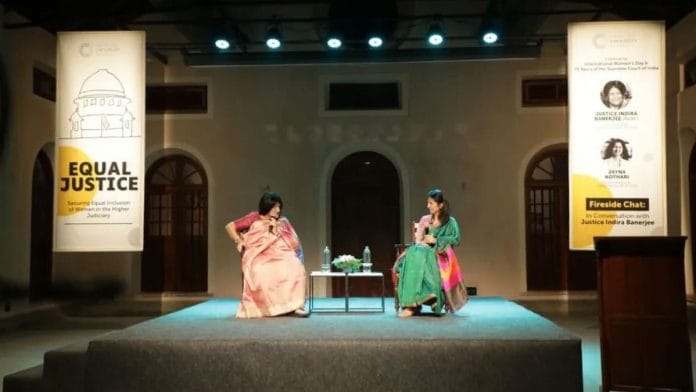Bengaluru: Former Supreme Court Judge Indira Banerjee’s phone beeped as she addressed the audience at Sabha, a heritage arts and performance venue in Bengaluru. It was an important alert—a female lawyer had been elevated directly from the Bar to the Calcutta High Court as an additional judge.
“One good news on Women’s Day,” said Banerjee, as around 150 people in the packed auditorium cheered and clapped. But Banerjee wasn’t impressed. Such fanfare when a woman judge is appointed is not warranted.
“It should become so normal that it actually starts being noticed as a norm rather than an achievement,” she said in a conversation with senior Supreme Court advocate Jayna Kothari on the slow progress of India’s judiciary towards gender inclusion. They had been invited by the Centre for Law and Policy Research (CLPR) to mark International Women’s Day on 8 March. But the conversation was anything but celebratory.
They examined the representation of women in the Indian judiciary—and found it lacking. The Supreme Court, which marked its 75th anniversary in January this year, has never had a female Chief Justice. During this same period, nine men from the Bar have been directly elevated to the Supreme Court, but only one woman has been given this opportunity, according to a CLPR study referred to by Kothari during the conversation.
Banerjee’s rise to the Supreme Court was marked by instances of gender discrimination.
“All of these challenges still persist. Unless a woman is very assertive, she will get cornered in the profession. But when women constitute 50 per cent of the population, you can’t leave them out in the legal field. We need systemic change,” she said.
Also read: Can women judges do naagin dance at house party? No, only male judges can flex on Instagram
Handling stereotypes
Banerjee was only 44 years old when she was appointed as a judge at the Calcutta High Court.
However, even before entering the profession, Banerjee faced discrimination. When she applied to a law firm, she was shortlisted alongside a male candidate. Though she was better qualified, and more experienced, the firm was initially inclined to hire the male candidate.
“They didn’t want to incur the extra expense of late-night transportation for a woman if she had to attend events or conferences,” she said.
At least four senior male judges refused to take her into their chambers, simply because she was a woman.
“This was one of the toughest challenges I faced. As a first-generation lawyer, I needed to find a foothold in a senior’s chamber to be able to fight in assisting cases,” said Banerjee.
She recalled how eventually a woman—Anushila Basu—referred her to the chamber of Samaraditya Pal, one of the top lawyers in Constitutional Law in the Calcutta High Court.
It was Pal’s wife, former Supreme court justice Ruma Pal, who guided her in those early days.
“Whenever I was apprehensive about my senior, I wouldn’t go to his office, I would go to Ruma instead. It was the women who ultimately came forward to help me,” she added.
Banerjee was elevated to the Supreme Court after almost 16 years of judgeship.
She said many justifications are given for not appointing women.
“Sometimes they say there are not enough eligible women candidates or not enough women with seniority, others claim that women do not want to become judges,” Kothari added.
Today, the Supreme Court has only two female judges out of a total strength of 33. One of the two judges, Bela Trivedi, is set to retire in June 2025. Across the country’s high courts, women make up only 14.42 per cent of the judiciary. The Allahabad High Court, which is the largest high court in the country with 79 judges at present, has only three women judges (2 per cent), according to a study by the Centre for Law and Policy Research.
Not only is there a disproportionately low number of women judges in the high courts, but they are also appointed much later than their male counterparts, according to the CLPR study. The average age of appointment for men is 51.8 years, but for women, it is 53 years. Hence, women judges do not reach positions of seniority.
“Late appointments result in women having lower seniority, which prevents them from becoming the Chief Justice of India (CJI) or being included in the Collegium. This is the biggest area of disparity,” said Kothari.
Also read: Rule of law and rural tradition – how women judges are walking the tightrope in Rajasthan
Difficult to deal with?
When Justice Banerjee was appointed as a Supreme Court of India judge in 2018, she was only the eighth woman to hold the position in the country’s history. There have only been 11 women justices in the top court. Since her retirement in September 2022, no women have been appointed as judges to the top court. The most recent female appointees were Justice Hima Kohli, Justice Bela Trivedi and Justice BV Nagarathna who joined the bench on 31 August 2021.
To address this imbalance, Banerjee and Kothari recommended that there must be an increase in appointments of women candidates.
“Judges should also be proactive and request public sector undertakings, state and centre, to ensure that women are included on their panels while fighting cases,” said Banerjee.
A female practicing lawyer in the audience then posed a question to Banerjee, about how to respond to legal professionals who say women judges are ‘difficult’ to deal with.
“Aren’t difficult male judges also hard to deal with?” Banerjee said. “Such deep-rooted stereotypical mindsets about a woman need to change.”
(Edited by Theres Sudeep)






